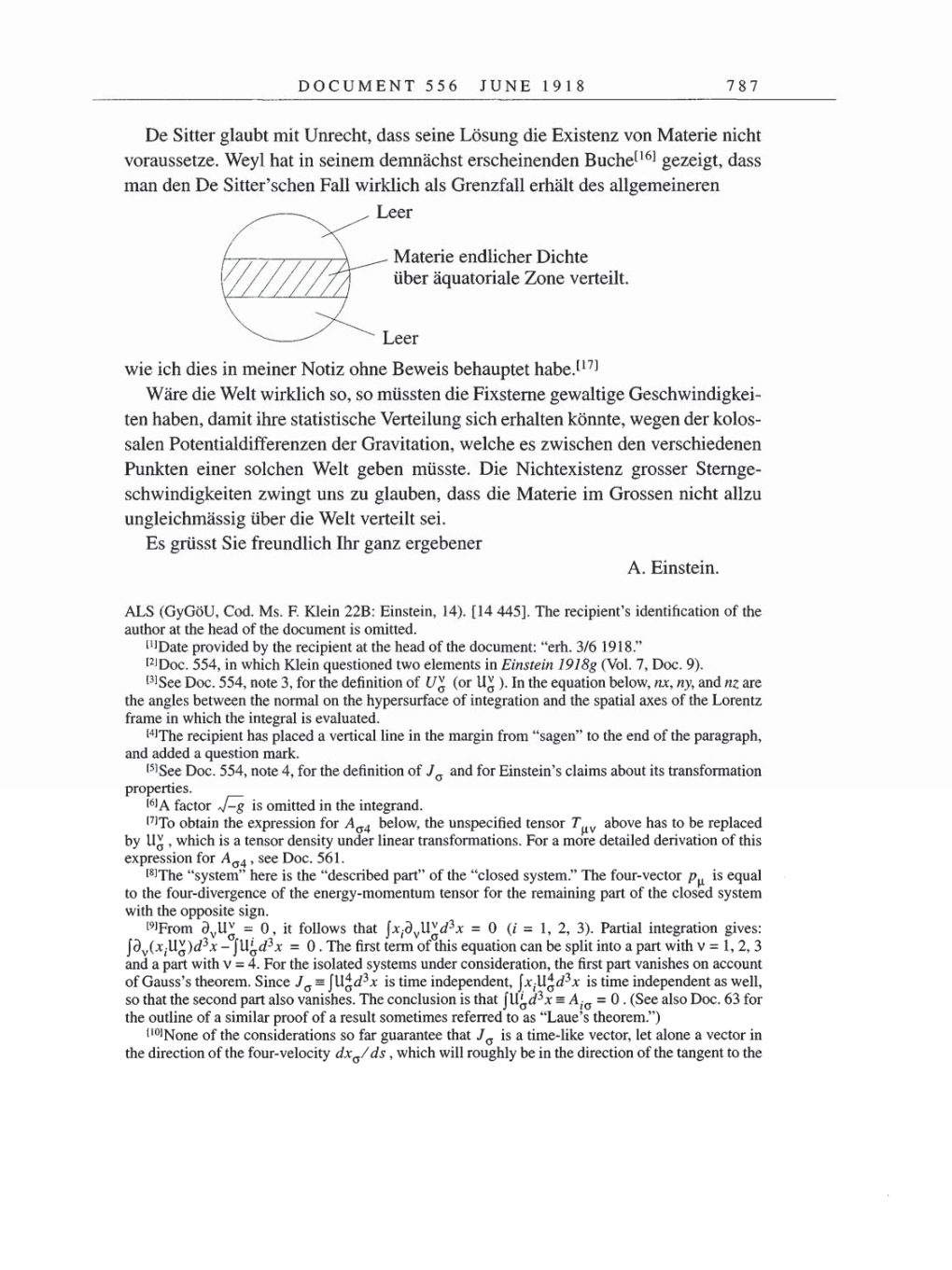DOCUMENT
556
JUNE 1918 787
De Sitter
glaubt
mit
Unrecht,
dass seine
Lösung
die Existenz
von
Materie nicht
voraussetze.
Weyl
hat in seinem demnächst erscheinenden
Buche[16]
gezeigt,
dass
man
den De Sitter’schen Fall wirklich als Grenzfall erhält des
allgemeineren
Leer
Materie endlicher Dichte
uber aquatoriale Zone verteilt.
Leer
wie ich dies in meiner Notiz ohne Beweis
behauptet
habe.[17]
Wäre
die Welt
wirklich
so,
so
müssten
die
Fixsterne
gewaltige Geschwindigkei-
ten haben,
damit
ihre statistische
Verteilung
sich
erhalten
könnte,
wegen
der
kolos-
salen Potentialdifferenzen der
Gravitation,
welche
es
zwischen den verschiedenen
Punkten einer solchen Welt
geben
müsste. Die Nichtexistenz
grosser Sternge-
schwindigkeiten zwingt
uns zu
glauben,
dass die Materie im Grossen nicht allzu
ungleichmässig
über die Welt verteilt sei.
Es
grüsst
Sie
freundlich Ihr
ganz
ergebener
A. Einstein.
ALS
(GyGöU,
Cod. Ms.
F.
Klein 22B:
Einstein, 14). [14 445].
The
recipient’s
identification
of
the
author
at
the head
of
the document is omitted.
[1]Date
provided by
the
recipient
at the head
of
the document: "erh. 3/6 1918."
[2]Doc. 554,
in which Klein
questioned
two
elements in Einstein
1918g (Vol.
7,
Doc.
9).
[3]See
Doc.
554, note 3,
for
the definition
of
Uvo
(or
Uvo).
In the
equation
below, nx,
ny,
and
nz are
the
angles
between
the normal
on
the
hypersurface
of
integration
and the
spatial axes
of
the
Lorentz
frame in which the
integral
is evaluated.
[4]The recipient
has placed
a
vertical line
in the
margin
from "sagen" to
the end
of
the
paragraph,
and added
a question
mark.
[5]See
Doc.
554,
note
4,
for the definition
of
Ja
and for Einstein’s claims about its transformation
properties.
[6]A factor
J-g
is omitted in the
integrand.
[7]To obtain the
expression
for
Aa4
below,
the
unspecified
tensor
Tuv
above has
to
be
replaced
by
Uvo,
which is
a
tensor
density
under linear transformations. For
a more
detailed derivation
of
this
expression
for
Aa4, see
Doc. 561.
[8]The
"system" here is the
"described
part"
of
the "closed
system."
The four-vector
pu
is
equal
to the
four-divergence
of
the
energy-momentum tensor
for
the
remaining part
of
the closed
system
with the
opposite sign.
[9]From
dvUvo
=
0,
it follows that
JxidvUvod3x =
0
(i
=
1,
2, 3).
Partial
integration gives:
J3v(xiUvo)d3x
-
jUiad3x
=
0.
The first term
of
this
equation
can
be
split
into
a
part with
v
=
1,
2, 3
and
a part
with
v
=
4. For the isolated
systems
under
consideration,
the first
part
vanishes
on
account
of
Gauss’s theorem. Since
Ja
= JU4od3x
is time
independent,
JxiU4od3x
is time
independent as
well,
so
that the second
part
also vanishes. The conclusion is
that
JUiod3x
=
Aio =
0.
(See
also Doc. 63 for
the outline
of
a
similar
proof
of
a
result sometimes
referred
to
as
"Laue’s
theorem.")
[10]None
of
the considerations
so
far
guarantee
that
Jo
is
a
time-like
vector,
let alone
a
vector in
the
direction
of
the
four-velocity
dxo/ds,
which
will
roughly
be in the direction
of
the
tangent
to
the
